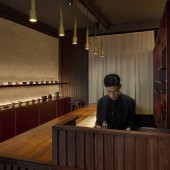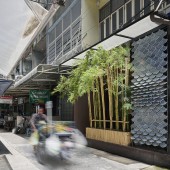
| THE AWARD |
| CATEGORIES |
| REGISTRATION |
| SUBMIT YOUR WORK |
| ENTRY INSTRUCTIONS |
| TERMS & CONDITIONS |
| PUBLICATIONS |
| DATES & FEES |
| METHODOLOGY |
| CONTACT |
| WINNERS |
| PRESS ROOM |
| GET INVOLVED |
| DESIGN PRIZE |
| DESIGN STORE |
| THE AWARD | JURY | CATEGORIES | REGISTRATION | PRESS | WINNERS | PUBLICATIONS | ENTRY INSTRUCTIONS |
Koto Tea Space Cafe by Takanao Todo |
Home > Winners > Design #154704 >Interview |
 |
|
FS: What is the main principle, idea and inspiration behind your design?
TT: In order to create a sense of silence and escape from bustling city to enjoy tea, I have applied the Japanese Design Concept, "Sichu no Sankyo", country house in the city. In order to actualize this concept, there is a need to make layers to filter the noise, and making a sequence to escape from public area to private area through the change of spatial volume and materiality.
FS: What has been your main focus in designing this work? Especially what did you want to achieve?
TT: The main focus of this project is rather than imitating Japanese style, the main focus of this project is to translate the Japanese design concept in a contemporary manner.
FS: What are your future plans for this award winning design?
TT: I am planning to design a new tea shop with the same owner. I would love to examine another Japanese design concept in more distilled and bold manner, while keeping the mood for the tea.
FS: How long did it take you to design this particular concept?
TT: It took roughly 3 years to have the current condition of the tea space, and there were 3 phases in design. 1st year, the first interior renovation. 2nd year, an addition of the ceramic screen. 3rd year, an addition of the tatami space, and change in a display.
FS: Why did you design this particular concept? Was this design commissioned or did you decide to pursuit an inspiration?
TT: I am engaging with the Thai Japanese Tea community, and the owner was one of the member in the community. This shop manage to boost the trend in Thailand for a new standard for the Japanese Tea Space in Bangkok.
FS: Is your design being produced or used by another company, or do you plan to sell or lease the production rights or do you intent to produce your work yourself?
TT: I would like to build the relationship with the same client to develop the sequel with application of other design concepts.
FS: What made you design this particular type of work?
TT: As myself is also a tea enthusiast, practicing Japanese tea, and making tea bowls, this project came naturally.
FS: Where there any other designs and/or designers that helped the influence the design of your work?
TT: I respect the idea of "eternal modernity". I have made some design and proportional reference from classical Japanese tea spaces such as, Shugaku-in palace, and Tai-an by Rikyu.
FS: Who is the target customer for his design?
TT: Thai upper middle customers who seeks for new experiences. I am wishing that this boosting the new Thai culture.
FS: What sets this design apart from other similar or resembling concepts?
TT: This tea space is designed utilizing the design concept. Many similar services copy the style. There is a significant difference.
FS: How did you come up with the name for this design? What does it mean?
TT: Koto means Japanese harp, which the owner possesses the antique Koto in prior to the design, and the owner took the name from it. Koto is also an essential element in Japanese Sencha Tea culture as well.
FS: Which design tools did you use when you were working on this project?
TT: Most of the design work was done in Rhinoceros
FS: What is the most unique aspect of your design?
TT: Interpretation of the Japanese Design Concept rather than imitation.
FS: Who did you collaborate with for this design? Did you work with people with technical / specialized skills?
TT: I have collaborated with several designers. lighting designer, ambiguous lighting from Singapore advice the lighting design, Mo Jirachaisakul worked on the ceramic cladding production, and Sojorn Design Studio for constructing the additional tatami space.
FS: What is the role of technology in this particular design?
TT: Ceramic cladding at the exterior was produced using 3D print mold, and digital simulation to determine the arrangement of the tiles.
FS: Is your design influenced by data or analytical research in any way? What kind of research did you conduct for making this design?
TT: The ceramic cladding arrangement was determined by the light path, wind flow, and visual porosity simulations. It was the Chulalongkorn University research grant project, and later the academic journal was released based on the performance of the screen.
FS: What are some of the challenges you faced during the design/realization of your concept?
TT: The first challenge was the original structure which was not in a good condition, therefore a major restoration was needed. The second challenge was the constructors who do not follow the design instruction, thus frequent site visit was needed to communicate with them beyond the language barrier. And the last challenge was to have the simultaneous communication with the client to align the vision together.
FS: How did you decide to submit your design to an international design competition?
TT: It is my first interior work, and it is also important for this tea space to be recognized not only as a Japanese tea space, and the interior space with a design thought.
FS: What did you learn or how did you improve yourself during the designing of this work?
TT: I would improve on finding more reliable contractor, which I found later in the design stage. It is also important to make a better alignment of the vision together with the client.
FS: Any other things you would like to cover that have not been covered in these questions?
TT: not applied
FS: Thank you for providing us with this opportunity to interview you.
A' Design Award and Competitions grants rights to press members and bloggers to use parts of this interview. This interview is provided as it is; DesignPRWire and A' Design Award and Competitions cannot be held responsible for the answers given by participating designers.
| SOCIAL |
| + Add to Likes / Favorites | Send to My Email | Comment | View Press-Release |





